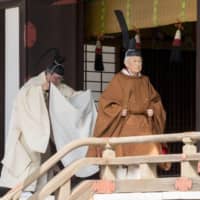Emperor Akihito on Tuesday took part in a rite at the Imperial Palace to report his planned abdication to his ancestors, kicking off a series of rituals and ceremonies — set to extend over months — related to the succession.
The 85-year-old, set to abdicate the throne on April 30, will become the first Japanese monarch in about two centuries to step down. He will be succeeded by his elder son, Crown Prince Naruhito, 59, the following day. In a ceremony Tuesday, the Emperor wore traditional attire and offered the report at sanctuaries within the Tokyo palace.
The succession events involving Emperor Akihito will end with a ceremony marking his relinquishment of the throne at the end of next month, during which he is to deliver a speech. He will also again ceremonially report the abdication to his ancestors at the Imperial Palace.
On March 26, Emperor Akihito and Empress Michiko will visit the Nara Prefecture mausoleum of Emperor Jimmu, Japan's legendary first Emperor, to report the abdication.
The Emperor will also travel to the Grand Shrines of Ise in Mie Prefecture on April 18 and the Tokyo mausoleum of his father, Emperor Showa, on April 23 for the same purpose.
Crown Prince Naruhito, who will ascend to the Chrysanthemum Throne on May 1, will report to the ancestors at a ceremony at the Imperial Palace on May 8. He will also make similar reports on Oct. 22, the day of his Enthronement Ceremony, and during the Nov. 14-15 Daijosai thanksgiving ceremony.
Emperor Akihito expressed his desire to abdicate in a rare video message in August 2016, citing concern that he might not be able to fulfill official duties due to his age. In June 2017, Japan enacted one-off legislation enabling him to step down.



